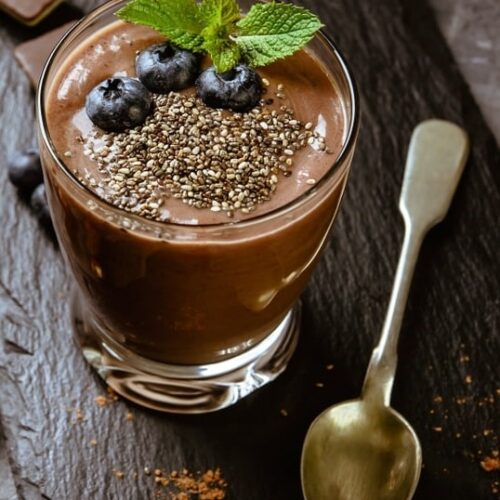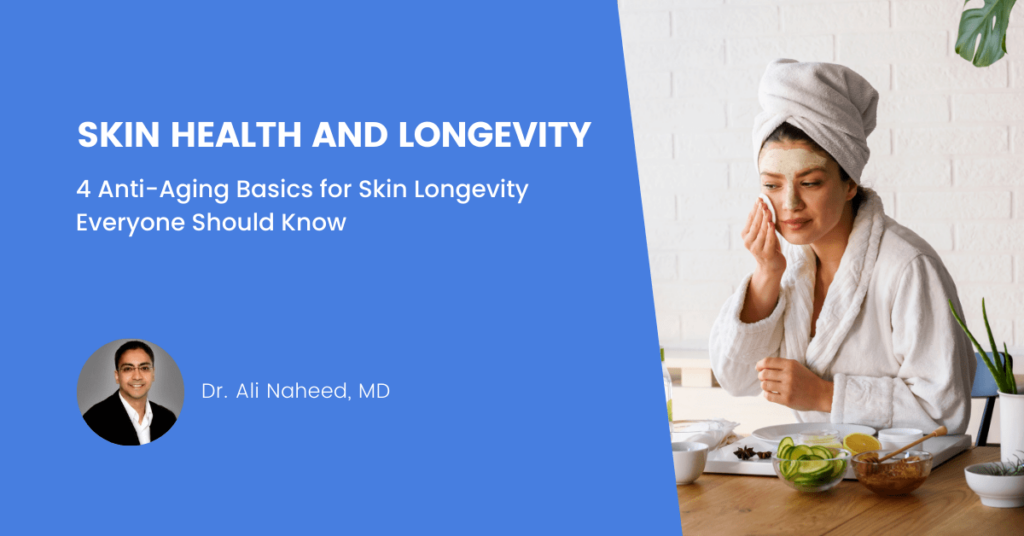- 4 Anti-Aging Basics for Skin Longevity Everyone Should Know - April 29, 2022
Premature aging | Anti-aging tips | Prevent sun damage | Nutrition | Smoothie | Supplements | Skincare risks | References
Dr. Naheed Ali, MD, PhD, provides an overview with some practical guidelines we can all do to help prevent skin aging and keep our skin healthy and younger-looking at any age.
Skin aging is something we all dread. But, is there something we can really do about it? Is skin aging an inevitable part of life we should all accept, or are there ways to keep our skin young-looking regardless of our age?
In my view, having a glowing, vibrant skin should not be tied to what is written on your birth certificate. Clearly, there are age-related changes that happen to our skin and body as we get older. And due to genetics, some people tend to look younger than others. Still, there are plenty things which we can do that can help optimize the way we look and feel as we age.
I believe that an effective anti-aging approach to skin should cover much more than cosmetic treatments like Botox and dermal fillers. It has to consider the cause, or in other words, the mechanisms that cause our body and skin to age. In this overview, we will go over some of the top evidence-based strategies you can start with today, that can help you look younger and even slow down skin aging. As importantly, we’ll also take a look into some of the common mistakes I often see that can make your skin look older, and in fact, can accelerate aging all over your body.
What is our skin telling about our health
Let’s start with the basics. You may have heard that the skin is the mirror or window to our internal health. In fact, dermatologists often diagnose internal disorders by skin examination alone[1]. Acne for example, may be a sign of hormonal imbalances. A skin rash may be related to food sensitivities[2]. Low levels of certain vitamins, minerals, and fatty acids often manifest as various skin issues[3]. Our skin can reflect all these issues and much more.
keeping a healthy skin is not just a matter of aesthetics. It is essential to our health.
Our skin is our largest organ[4]. It is intimately connected to our entire physiology and overall health. Whether it is a microbial threat, toxins, regulate our body’s temperature on a hot or cold day, or the ability to properly heal after a cut. The skin is our first line of defense, and a potent barrier that protects us from harmful substances and threats we come in contact with from our environment. For example, preventing the entry of foreign substances and hostile microorganisms that may cause us harm. In the event of an insult, the skin immune cells are crucial not only for prevention of infection but also for tissue reconstruction[5].
Healthy skin aging vs. premature skin aging
Now, when it comes to skin aging, we need to differentiate between healthy aging to premature skin aging. While everyone eventually experiences signs of skin aging, many people notice signs much earlier in life. Some of these signs may include:
- Excessive sunspots or age spots
- Wrinkles
- Sagging and/or dry skin
- Poor complexion
- Thin skin in the hands
- Hyperpigmentation, a condition where patches of skin may appear darker in color than the surrounding skin.
- Skin inflammation, redness
The aging process is distinct for everyone, with both genetics and lifestyle play a role. While we can’t change our genetics, there are plenty of things we can control with lifestyle that can promote a healthy youthful-looking skin. In fact, multiple studies in the area of epigenetics have demonstrated that certain lifestyle choices can turn off genes that are known to accelerate aging, and on the flip side, activate longevity genes that can protect us as we age.
The 4 basic principles of skin longevity
As I mentioned, I believe that an effective anti-aging approach to skin must consider the potential risk factors, and key aging mechanisms that cause our body and skin to age. This way, you address much more than just appearance. You support the health and longevity of your skin, and in fact, your entire body.
I consider the following the basics of skin longevity:
1. Prevent skin aging from excessive sun exposure
Photoaging refers to skin damage caused by prolonged sun exposure, specifically UVA and UVB rays, and can lead to skin cancers. Many of the skin changes that occur as we age are accelerated by sun exposure. Photoaging can be prevented or slowed down with proper protection from the sun’s harmful rays with the use of SPF 30+ sunscreen[6].
With that said, there are many benefits of being outdoors and getting natural daylight, including the fact that this is the best ways to get vitamin D. And vitamin D is crucial to our health and as it turned out, to our longevity. Researchers at the Buck Institute on aging found that vitamin D was able to extended median lifespan in worms by 33 percent and even slowed the aging-related misfolding of proteins[7].
2. Optimize nutrition for healthy skin and longevity
Nutrition is one of the most basic key factors for healthy and youthful skin. Photoprotection by nutrients is well documented in the literature and while this doesn’t replace sunscreen and can still help protect against some sun damage from within. Some of the key nutrients include β-carotene (carrots and dark leafy greens are great sources), lycopene (found in tomatoes), vitamin C (precursor for collagen production), vitamin E, and polypodium, a tropical fern plant that may offer additional anti-aging benefits[8].
Ideally, it is best to have a balanced diet that provides your body all the basics, so you do not have nutritional deficiencies. Realistically, this is not always possible, and you may need some supplements to fill certain nutritional gaps. Pay extra attention to essential vitamins, minerals, essential amino acids and fatty acids which the body can’t synthesize from other nutrients. This means the only way to get enough of these nutrients, is from food or supplements. This is especially important if you follow a restricted diet, for example, one that is low in fats or protein. Or, if you follow a caloric restriction lifestyle.
Also, try to limit sugars and refined carbs as they are shown to degrade collagen which can accelerate skin aging. Other “brown” foods that are fried in high heat increase glycation, a process known to accelerate aging in the entire body.
My anti-aging smoothie for skin health
Eating healthy to support your longevity and nourish your skin from within can be very simple. Here’s an example of one of my favorite anti-aging smoothies for skin health. The smoothie contains powerful anti-aging skin-beautifying essential fats and antioxidants that not only taste delicious but are also very healthy. The antioxidants found in raw cacao for example, have been shown to protect the skin from the inside out by neutralizing oxidative stress, which is a major factor of skin structure deterioration and premature skin aging[9].

Dr. Naheed Anti-aging Beauty Smoothie for Skin Health
Equipment
- Blender
Ingredients
- 1 cup cold almond milk rich in essential fats and minerals
- 1 cup blueberries or mixed berries powerful antioxidant and anti-aging properties, also great for cognitive function
- 10-15 grams organic grass-fed collagen protein powder support skin firmness and elasticity
- 1 cup mixed raw organic greens A great source of beta carotene, precursor to vitamin A, and also: vitamin C, vitamin K, minerals and antioxidants
- ½ avocado Rich in essential fats and vitamin E
- 1 tablespoon raw dark cacao Contains antioxidants shown to protect the skin from the inside out by neutralizing oxidative stress which is a major factor of skin structure deterioration and premature skin aging[9].
- stevia or monk fruit Only if needed. These do not increase your blood sugar levels and are safe for keto and fasting
Instructions
- Mix all the ingredients and blend
- Sweeten with stevia or monk fruit if needed. These do not increase your blood sugar levels.
- Enjoy!
3. Try longevity supplements
Another nutritional strategy to slow the skin aging, is to address some of the common factors shown to drive the aging process in the body. As a result, you may notice better looking skin indirectly, along with many other benefits. These aging factors are known as the hallmark of aging, and include epigenetic alterations, deregulated nutrient-sensing, mitochondrial dysfunction, cellular senescence (zombie cells) and others[10].
Certain natural plant extracts from green tea, curcumin (found in turmeric), resveratrol (found in small amounts in grapes and red wine), berberine, and others have been studied for their ability to influence many of these aging mechanisms. Consuming these plants can safely activate our body’s own protective/longevity genes, and at the same time, inhibit mechanisms shown to accelerate aging.
LongeviLife is a great longevity blend of some of the most studied longevity promoting ingredients that can help support anti-aging efforts from within while also improving your overall wellbeing. As I have mentioned, the science on these natural ingredients is very promising and exciting.
4. Safe skin care
One of the most important aspects of maintaining healthy skin is avoiding mistakes that can damage the skin. Unfortunately, many people experience unnecessary pain and in some cases, permanent skin damage after trying risky procedures or products that contained harsh ingredients or chemicals.
It is important that you educate yourself about these treatments and make sure they are offered by qualified professionals. With all this marketing going on, some procedures or products may seem like a superb idea at first, but if the clinical approaches are not carefully considered then there could potentially be harmful consequences.
Until the next time,
All the best,
Dr. Naheed Ali
Read next: 7 Anti-aging Strategies to Flawless Youthful Skin at Any Age
